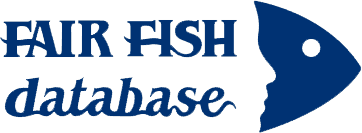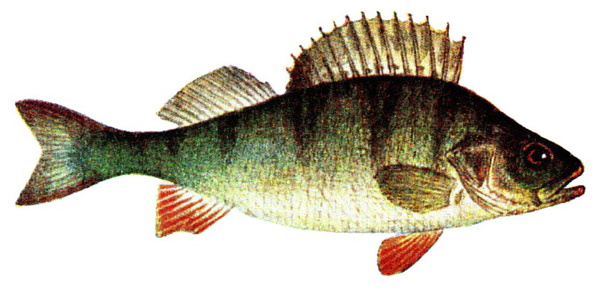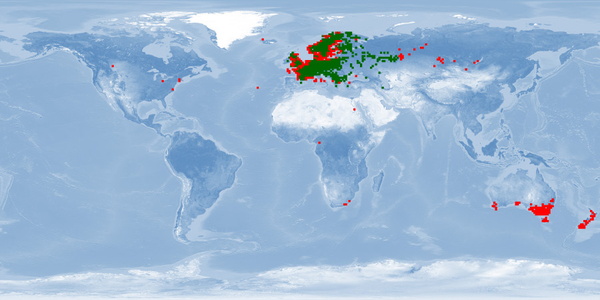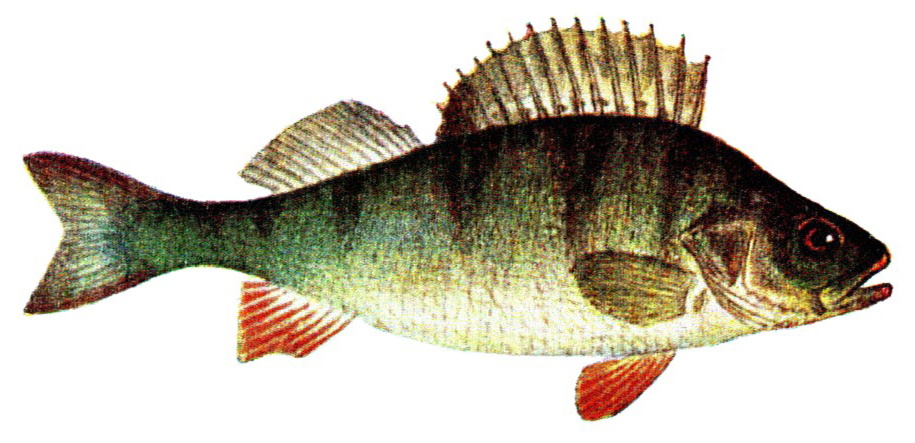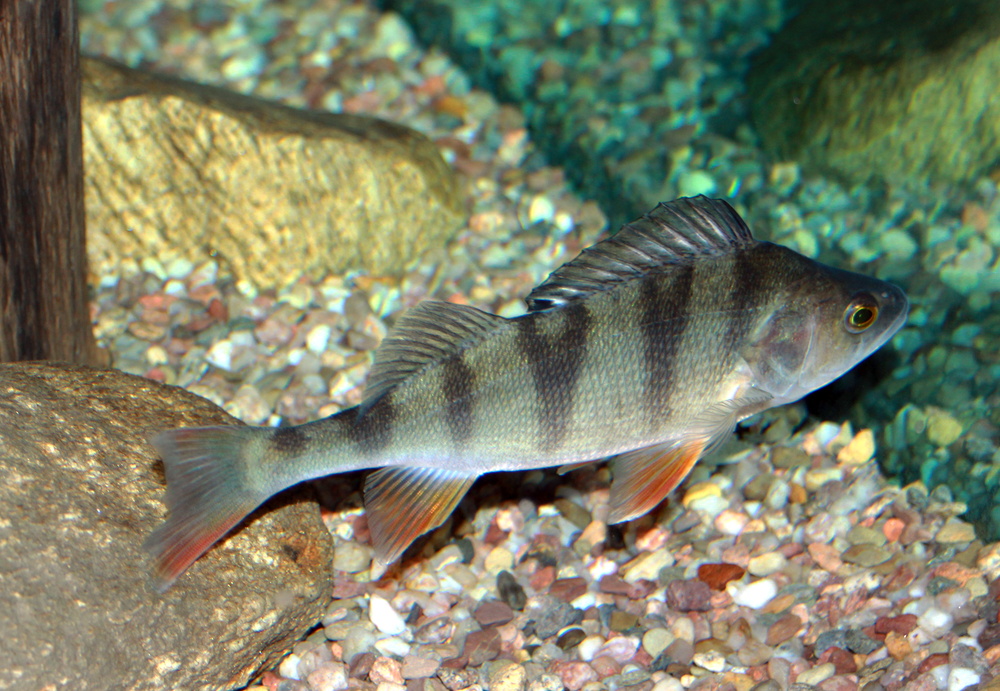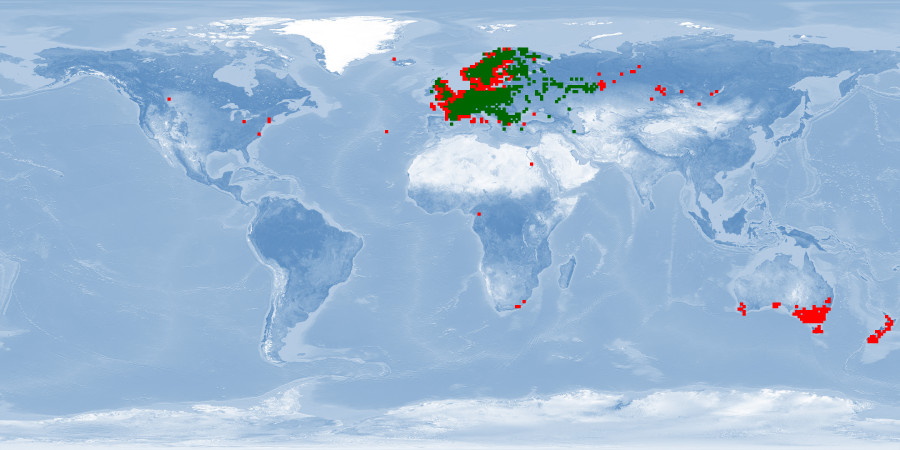Information
Version: B | 1.1 (2020-01-18)
1 Remarks
1.1 General remarks
No data found yet.1.2 Other remarks
No data found yet.2 Ethograms
In the farm or lab: on reproduction, social behaviour, cognitive abilities
3 Distribution


Natural distribution: Europe, inland and coastal waters
Introduced: inland waters worldwide
4 Natural co-existence
5 Substrate and/or shelter
5.1 Substrate
Substrate range, substrate preference: opportunistic – reported from lakes with plants as well as reservoirs with sandy, muddy, and rocky bottoms5.2 Shelter or cover
Shelter or cover preference: uses shelter during establishing hierarchy (further research needed)Shelter or cover and stress: enrichment increases number of attacks and chases (further research needed)
6 Food, foraging, hunting, feeding
6.1 Trophic level and general considerations on food needs
Trophic level: 4.4Impacts of feed fishery: contributes to overfishing, challenges animal welfare
6.2 Food items
Food items, food preference: carnivorous, increasing prey size with increasing age6.3 Feeding behaviour
Feeding style, foraging mode: littoralEffects on feeding: direct relation with temperature
For feeding and dominance ➝ D7.
7 Photoperiod
7.1 Daily rhythm
Daily rhythm: crepuscular (further research needed)Photoperiod and stress: nocturnal lighting influences circadian melatonin rhythm but not stress (further research needed)
7.2 Light intensity
No data found yet.7.3 Light colour
No data found yet.8 Water parameters
8.1 Water temperature
Standard temperature range, temperature preference: 6.1-28 °CTemperature and growth: must exceed 13-14 °C (further research needed)
8.2 Oxygen
Dissolved oxygen range: <10-150%, 6-9 mg/L8.3 Salinity
Salinity tolerance, standard salinity range: probably euryhaline (further research needed)8.4 pH
No data found yet.8.5 Turbidity
Standard turbidity range: Secchi depth 1.1-7.5 m8.6 Water hardness
No data found yet.8.7 NO4
No data found yet.8.8 Other
No data found yet.9 Swimming
9.1 Swimming type, swimming mode
Swimming type, swimming mode: sub-carangiform9.2 Swimming speed
No data found yet.9.3 Home range
No data found yet.9.4 Depth
Depth range, depth preference: 0-18.5 m, moves deeper with decreasing temperatures9.5 Migration
No data found yet.10 Growth
10.1 Ontogenetic development
Mature egg: 0.9-1.6 mm diameter, average 8.7 mgLarvae: hatching to 15-17 days, 4.8-6.5 mm, average 0.9-1.0 mg
Fry: beginning of exogenous feeding, 4-34 days, 9-23 mm, 18-22 mg
Juveniles, sexual maturity: fully developed (ca 2 months) to beginning of maturity (0-4 years), 6.4-19.9 cm, 9-126 g
Adults: 4-15 years, 10-34+ cm, 22-880 g
10.2 Sexual conversion
No data found yet.10.3 Sex ratio
No data found yet.10.4 Effects on growth
Growth rate: 5-7 cm/year in first year, 1-2 cm/year from fifth year onGrowth and sex: bimodal pattern, noticeable from the second or third year on
For growth and...
...water temperature ➝ D12,
...water temperature and disturbance ➝ D6,
...tank colour ➝ D5.
10.5 Deformities and malformations
No data found yet.11 Reproduction
11.1 Nest building
Nest building: none11.2 Attraction, courtship, mating
Courtship sequence: female encircles water plants for ca 30 min, increasing in speed (further research needed)11.3 Spawning
Mating system: polyandry (further research needed)Spawning conditions: gravel or submerged vegetation, winter-spring, 11-22 °C, 0-12 m depth
Male:female ratio resulting in spawning, composition of the broodstock: 1:4.6 (further research needed)
Spawning sequence: female releases single egg strand, several males release milt simultaneously (further research needed)
11.4 Fecundity
Female fecundity: 33,000-146,000 eggs/kg body weight11.5 Brood care, breeding
Breeding type: lake spawner12 Senses
12.1 Vision
Visible spectrum: mainly green, red, but also violet (further research needed)Importance of vision: predator avoidance (further research needed)
Tank colour and growth: better visibility via contrast of light food in dark tanks or vice versa
12.2 Olfaction (and taste, if present)
Importance of olfaction: predator avoidance12.3 Hearing
Hearing type, hearing spectrum: hearing generalist, 0.1-0.3 kHz (further research needed)Noise and stress: sensitive to fluctuating noise (in amplitude and frequency) (further research needed)
12.4 Touch, mechanical sensing
No data found yet.12.5 Lateral line
No data found yet.12.6 Electrical sensing
No data found yet.12.7 Nociception, pain sensing
No data found yet.12.8 Other
No data found yet.13 Communication
13.1 Visual
Colouration and habitat: increasing colouration with increasing water transparency (further research needed)13.2 Chemical
No data found yet.13.3 Acoustic
No data found yet.13.4 Mechanical
No data found yet.13.5 Electrical
No data found yet.13.6 Other
No data found yet.14 Social behaviour
14.1 Spatial organisation
Aggregation type: shoaling with increasing body size, as juveniles and adults schooling (further research needed)Stocking density in the wild: 0.1-8.1 ind/m, 30-89,111 ind/ha (further research needed)
Stocking density and stress: inverse relation below 10,000 ind/cage or 25-30 kg/m3 (further research needed)
14.2 Social organisation
Social organisation type: linear hierarchy (when in small groups) (further research needed)Features of dominance: defend shelter, higher feed intake (further research needed)
Features of subordination: hardly move, avoid contact with the dominant (further research needed)
14.3 Exploitation
Cannibalism, predation: contribution to diet differs, most likely depending on habitat overlap and thus food competition14.4 Facilitation
No data found yet.14.5 Aggression
Aggression and stocking density: inverse relation below 25-30 kg/m3 (further research needed)For aggression (or lack thereof)...
...and environmental enrichment ➝ D16,
...courtship ➝ D17.
14.6 Territoriality
No data found yet.15 Cognitive abilities
15.1 Learning
Classical conditioning: may be used for measuring perceptionOperant or instrumental conditioning: may be used for managing self-feeder, measuring perception
15.2 Memory
No data found yet.15.3 Problem solving, creativity, planning, intelligence
No data found yet.15.4 Other
Predator recognition: influences feeding behaviour (further research needed)16 Personality, coping styles
17 Emotion-like states
17.1 Joy
No data found yet.17.2 Relaxation
No data found yet.17.3 Sadness
No data found yet.17.4 Fear
No data found yet.18 Self-concept, self-recognition
19 Reactions to husbandry
19.1 Stereotypical and vacuum activities
No data found yet.19.2 Acute stress
Handling: air exposure is stressful (further research needed)Live transport: stressful (further research needed)
For acute stress and noise ➝ D22.
19.3 Chronic stress
Handling: no effect of domestication (further research needed)Husbandry disturbance: stressful (further research needed)
For chronic stress and...
...environmental enrichment ➝ D16,
...nocturnal lighting ➝ D23,
...stocking density ➝ D24.
19.4 Stunning reactions
Stunning rules: fast, effective, safeStunning methods: percussive and electrical stunning most effective (further research needed)
Glossary
FARM = setting in farming environment or under conditions simulating farming environment in terms of size of facility or number of individuals
FRY = larvae from external feeding on
GENERALIST = Generalists detect a narrow bandwidth of sound frequencies (<50-500 Hz, 1,500 Hz max.). High hearing threshold = cannot detect quieter sounds. Typically no swim bladder or no attachment of the swim bladder to the inner ear. Live in loud environments (rivers) 43 44.
IND = individuals
JUVENILES = fully developed but immature individuals
LAB = setting in laboratory environment
LARVAE = hatching to mouth opening
MILLIARD = 1,000,000,000 26 27
TOTAL LENGTH = from snout to tip of caudal fin as compared to fork length (which measures from snout to fork of caudal fin) or standard length (from head to base of tail fin) or body length (from the base of the eye notch to the posterior end of the telson) 34
WILD = setting in the wild
Bibliography
2 Jellyman, D. J. 1980. Age, growth, and reproduction of perch, Perca fluviatilis L., in Lake Pounui. New Zealand Journal of Marine and Freshwater Research 14: 391–400. https://doi.org/10.1080/00288330.1980.9515881.
3 Craig, John F. 1977. Seasonal changes in the day and night activity of adult perch, Perca fluviatilis L. Journal of Fish Biology 11: 161–166.
4 Čech, M., J. Kubečka, J. Frouzová, V. Draštík, M. Kratochvíl, J. Matěna, and J. Hejzlar. 2007. Distribution of the bathypelagic perch fry layer along the longitudinal profile of two large canyon-shaped reservoirs. Journal of Fish Biology 70: 141–154. https://doi.org/10.1111/j.1095-8649.2006.01282.x.
5 Treasurer, J. W. 1981. Some aspects of the reproductive biology of perch Perca fluviatilis L. Fecundity, maturation and spawning behaviour. Journal of Fish Biology 18: 729–740. https://doi.org/10.1111/j.1095-8649.1981.tb03814.x.
6 Mikheev, Victor N., Anna F. Pasternak, Gerhard Tischler, and Josef Wanzenböck. 2005. Contestable shelters provoke aggression among 0+ perch, Perca fluviatilis. Environmental Biology of Fishes 73: 227–231. https://doi.org/10.1007/s10641-005-0558-8.
7 Karlsen, Hanserik. 1992. The Inner Ear is Responsible for Detection of Infrasound in the Perch (Perca Fluviatilis). Journal of Experimental Biology 171: 163–172.
8 Ferter, Keno, and Victor Benno Meyer-Rochow. 2010. Turning Night into Day: Effects of Stress on the Self-Feeding Behaviour of the Eurasian Perch Perca fluviatilis. Zoological Studies 49: 176–181.
9 Reviewed distribution maps for European perch (Perca fluviatilis). 2016. Aquamaps.
10 Baras, Etienne, Patrick Kestemont, and Charles Mélard. 2003. Effect of stocking density on the dynamics of cannibalism in sibling larvae of Perca fluviatilis under controlled conditions. Aquaculture 219: 241–255. https://doi.org/10.1016/S0044-8486(02)00349-6.
11 Ceccuzzi, Pietro, Genciana Terova, Fabio Brambilla, Micaela Antonini, and Marco Saroglia. 2011. Growth, diet, and reproduction of Eurasian perch Perca fluviatilis L. in Lake Varese, northwestern Italy. Fisheries Science 77: 533–545. https://doi.org/10.1007/s12562-011-0353-8.
12 Mikheev, V. N., J. Wanzenböck, and A. F. Pasternak. 2006. Effects of predator-induced visual and olfactory cues on 0+ perch (Perca fluviatilis L.) foraging behaviour. Ecology of Freshwater Fish 15: 111–117. https://doi.org/10.1111/j.1600-0633.2006.00140.x.
13 Čech, M., J. Peterka, M. Říha, L. Vejřík, T. Jůza, M. Kratochvíl, V. Draštík, M. Muška, P. Znachor, and J. Kubečka. 2012. Extremely shallow spawning of perch (Perca fluviatilis L.): the roles of sheltered bays, dense semi-terrestrial vegetation and low visibility in deeper water. Knowledge and Management of Aquatic Ecosystems 406: 12. https://doi.org/10.1051/kmae/2012026.
14 Petrtýl, Miloslav, Lukáš Kalous, Jaroslava Frouzová, and Martin Čech. 2015. Effects of habitat type on short- and long-term growth parameters of the European perch (Perca fluviatilis L.): Size distribution and RNA/DNA ratio of European perch fry. International Review of Hydrobiology 100: 13–20. https://doi.org/10.1002/iroh.201301675.
15 Król, Jaroslaw, Nicolas Dauchot, Syaghalirwa N M Mandiki, Pierre van Cutsem, and Patrick Kestemont. 2015. Cannibalism in cultured eurasian perch, Perca fluviatilis (Actinopterygii: Perciformes: Percidae)-Implication of maternal influence, kinship, and sex ratio of progenies. Acta Ichthyologica et Piscatoria 45: 65–73. https://doi.org/10.3750/AIP2015.45.1.07.
16 Persson, Lennart, Pär Byström, and Eva Wahlström. 2000. Cannibalism and Competition in Eurasian Perch: Population Dynamics of an Ontogenetic Omnivore. Ecology 81: 1058–1071. https://doi.org/10.1890/0012-9658(2000)081[1058:CACIEP]2.0.CO;2.
17 Magnhagen, C., and E. Heibo. 2004. Growth in length and in body depth in young-of-the-year perch with different predation risk. Journal of Fish Biology 64: 612–624. https://doi.org/10.1111/j.1095-8649.2004.00325.x.
18 Heibo, Erik, Carin Magnhagen, and Leif Asbjørn Vøllestad. 2005. Latitudinal variation in life-history traits in Eurasian perch. Ecology 86: 3377–3386. https://doi.org/10.1890/04-1620.
19 Magnhagen, Carin, and Jost Borcherding. 2008. Risk-taking behaviour in foraging perch: does predation pressure influence age-specific boldness? Animal Behaviour 75: 509–517. https://doi.org/10.1016/j.anbehav.2007.06.007.
20 Kekäläinen, Jukka, Hannu Huuskonen, Vesa Kiviniemi, and Jouni Taskinen. 2010. Visual conditions and habitat shape the coloration of the Eurasian perch (Perca fluviatilis L.): a trade-off between camouflage and communication? Biological Journal of the Linnean Society 99: 47–59. https://doi.org/10.1111/j.1095-8312.2009.01339.x.
21 Froese, R., and D. Pauly. 2014. FishBase. World Wide Web electronic publication. www.fishbase.org.
22 FAO. 2014. The State of World Fisheries and Aquaculture 2014. Rome: Food and Agriculture Organization of the United Nations.
23 Watson, R., Jackie Alder, and Daniel Pauly. 2006. Fisheries for forage fish, 1950 to the present. In On the Multiple Uses of Forage Fish: from Ecosystems to Markets, ed. Jackie Alder and Daniel Pauly, 14:1–20. Fisheries Centre Research Reports 3. Vancouver, Canada: Fisheries Centre, University of British Columbia.
24 Mood, A. 2012. Average annual fish capture for species mostly used for fishmeal (2005-2009). fishcount.org.uk.
25 Mood, A., and P. Brooke. 2012. Estimating the Number of Farmed Fish Killed in Global Aquaculture Each Year.
26 Kopf, Von Kristin. 2012. Milliarden vs. Billionen: Große Zahlen. Sprachlog.
27 Weisstein, Eric W. 2018. Milliard. Text. MathWorld - a Wolfram Web resource. http://mathworld.wolfram.com/Milliard.html. Accessed February 2.
28 Heermann, Lisa, Werner Scharf, Gerard van der Velde, and Jost Borcherding. 2014. Does the use of alternative food resources induce cannibalism in a size-structured fish population? Ecology of Freshwater Fish 23: 129–140. https://doi.org/10.1111/eff.12060.
29 Brüning, Anika, Franz Hölker, Steffen Franke, Torsten Preuer, and Werner Kloas. 2015. Spotlight on fish: Light pollution affects circadian rhythms of European perch but does not cause stress. Science of The Total Environment 511: 516–522. https://doi.org/10.1016/j.scitotenv.2014.12.094.
30 Le Cren, E. D. 1958. Observations on the Growth of Perch (Perca fluviatilis L.) Over Twenty-Two Years with Special Reference to the Effects of Temperature and Changes in Population Density. Journal of Animal Ecology 27: 287–334. https://doi.org/10.2307/2242.
31 Hunt, Darcie Elizabeth. 2015. The effect of visual capacity and swimming ability of fish on the performance of light-based bycatch reduction devices in prawn trawls. Doctoral dissertation, University of Tasmania.
32 Voskoboinikova, O. S., and I. G. Grechanov. 2002. Development of the Skeleton during the Ontogenesis of the River Perch Perca fluviatilis. Journal of Ichthyology 42: 322–333.
33 Jentoft, Sissel, Sigurd ØXnevad, Are H. Aastveit, and ØIvind Andersen. 2006. Effects of Tank Wall Color and Up-welling Water Flow on Growth and Survival of Eurasian Perch Larvae (Perca fluviatilis). Journal of the World Aquaculture Society 37: 313–317. https://doi.org/10.1111/j.1749-7345.2006.00042.x.
34 Pawson, M.G., and G.D. Pickett. 1996. The Annual Pattern of Condition and Maturity in Bass, Dicentrarchus Labrax, in Waters Around England and Wales. Journal of the Marine Biological Association of the United Kingdom 76: 107. https://doi.org/10.1017/S0025315400029040.
35 Konstantinov, K. G. 1957. Comparative analysis of morphology and biology of perch, pikeperch, Volga pikeperch of different stages of development. Rep. Inst. Evol. Morph. Anim. 16: 181–236.
36 Acerete, L, J. C Balasch, E Espinosa, A Josa, and L Tort. 2004. Physiological responses in Eurasian perch (Perca fluviatilis, L.) subjected to stress by transport and handling. Aquaculture 237: 167–178. https://doi.org/10.1016/j.aquaculture.2004.03.018.
37 Strand, Å., C. Magnhagen, and A. Alanärä. 2007. Effects of repeated disturbances on feed intake, growth rates and energy expenditures of juvenile perch, Perca fluviatilis. Aquaculture 265: 163–168. https://doi.org/10.1016/j.aquaculture.2007.01.030.
38 Strand, Å., A. Alanärä, F. Staffan, and C. Magnhagen. 2007. Effects of tank colour and light intensity on feed intake, growth rate and energy expenditure of juvenile Eurasian perch, Perca fluviatilis L. Aquaculture 272: 312–318. https://doi.org/10.1016/j.aquaculture.2007.08.052.
39 Douxfils, J., S. Lambert, C. Mathieu, S. Milla, S. N. M. Mandiki, E. Henrotte, N. Wang, et al. 2014. Influence of domestication process on immune response to repeated emersion stressors in Eurasian perch (Perca fluviatilis, L.). Comparative Biochemistry and Physiology Part A: Molecular & Integrative Physiology 173: 52–60. https://doi.org/10.1016/j.cbpa.2014.03.012.
40 Cameron, N. E. 1982. The photopic spectral sensitivity of a dichromatic teleost fish (perca fluviatilis). Vision Research 22: 1341–1348. https://doi.org/10.1016/0042-6989(82)90223-1.
41 Amoser, Sonja, and Friedrich Ladich. 2005. Are hearing sensitivities of freshwater fish adapted to the ambient noise in their habitats? Journal of Experimental Biology 208: 3533–3542. https://doi.org/10.1242/jeb.01809.
42 Wysocki, Lidia Eva, John P. Dittami, and Friedrich Ladich. 2006. Ship noise and cortisol secretion in European freshwater fishes. Biological Conservation 128: 501–508. https://doi.org/10.1016/j.biocon.2005.10.020.
43 Brown, Culum. 2015. Fish intelligence, sentience and ethics. Animal Cognition 18: 1–17. https://doi.org/10.1007/s10071-014-0761-0.
44 Amundsen, Lasse, and Martin Landro. 2011. Marine seismic sources part VIII: Fish hear a great deal. Recent Advances in Technology 8: 1–5.
45 Robb, D H F, and S C Kestin. 2002. Methods Used to Kill Fish: Field Observations and Literature Reviewed. Animal Welfare 11: 269–282.
46 Stamer, Andreas. 2009. Betäubungs- und Schlachtmethoden für Speisefische. Report.
❮
❯




«
